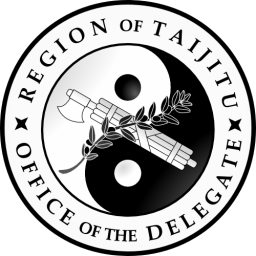Difference between revisions of "Cabinet of Taijitu"
(+History) |
(+Appointment and removal) |
||
| Line 8: | Line 8: | ||
During a convention to create a new constitution in May of 2010, it was decided to keep the Cabinet as it was under the previous Constitution. This decision was affirmed on June 20 when the new constitution was formally ratified. Under it the [[Ministries Act]] was signed into law on August 2 of the same year, defining the ministries of the Cabinet. | During a convention to create a new constitution in May of 2010, it was decided to keep the Cabinet as it was under the previous Constitution. This decision was affirmed on June 20 when the new constitution was formally ratified. Under it the [[Ministries Act]] was signed into law on August 2 of the same year, defining the ministries of the Cabinet. | ||
| + | |||
| + | ==Appointment and removal== | ||
| + | Ministers are appointed by the [[Delegate of Taijitu|Delegate]] and do not require [[Senate of Taijitu|Senate]] confirmation to take office. The Delegate may likewise freely remove them from office. The Senate may also force the removal of a minister by a majority vote. Because they are unelected, ministers may not be recalled in a referendum. | ||
{{Navbox Government}} | {{Navbox Government}} | ||
{{stub}} | {{stub}} | ||
Revision as of 05:55, 7 June 2012
| Cabinet of Taijitu | |
|---|---|
| History | |
| Formation | Constitution of Taijitu June 20, 2010 |
| Leadership | |
| Delegate | Myroria |
| Structure | |
| Ministries | Ministry of Community Ministry of Defense Ministry of External Affairs Ministry of Internal Affairs Ministry of Justice |
| Members | Myroria Inglo-Scotia The Crazy Monkeymen St Oz |
| Political groups | Taijitu Nationalist Alliance Independent |
| Selection | |
| Method | Delegate appointment |
| Term length | Indefinite |
| Meeting place | |
| Executive forums | |
The Cabinet of Taijitu is the body responsible for assisting the Delegate in administering the government. It is composed of a number of ministers appointed by the Delegate, who are responsible for running certain ministries. There is no limit on how long a minister may serve, but they may be removed freely by the Delegate and by a vote of the Senate.
History
The Cabinet as originally established by the first constitution of Taijitu favored the executive. Ministers required a two-thirds super-majority vote of the Senate to be removed, instead of a simple majority, and the Senate had no power to compel the creation of certain ministries. This was soon changed by a constitutional amendment on April 16, 2007, which gave the Senate the power to create ministries by law and remove ministers by a simple majority vote.
On March 23, 2008, a coup was used to forcibly instate a new constitution, which gave the Delegate unprecedented powers over the Cabinet. The Senate's legislative replacement, the Citizen's Assembly, was not only unable to create ministries by law, but also unable to remove ministers from office. This constitution, however, was short lived, and the Senate and its controls over the Cabinet were restored in full later later that year by a new constitution.
During a convention to create a new constitution in May of 2010, it was decided to keep the Cabinet as it was under the previous Constitution. This decision was affirmed on June 20 when the new constitution was formally ratified. Under it the Ministries Act was signed into law on August 2 of the same year, defining the ministries of the Cabinet.
Appointment and removal
Ministers are appointed by the Delegate and do not require Senate confirmation to take office. The Delegate may likewise freely remove them from office. The Senate may also force the removal of a minister by a majority vote. Because they are unelected, ministers may not be recalled in a referendum.
| Government of Taijitu | |||||
|---|---|---|---|---|---|
| Legislative | Ecclesia · Citizen-Initiator | Executive | Delegate · Citizen-Diplomats · Citizen-Liaison · Armed Forces . Citizen-Sergeant | Constitution | Constitution |
| Laws | Alliance Between Taijitu and The North Pacific . Citizen-Initiator Act .Citizen-Liaison Act. Citizenship Act . Delegacy Act . Flag and Seals Act · Holidays Act . Judiciary Act . Militia Act . Noble Houses Act . Revolutionary Calendar Act . The Rejected Realms - Taijitu Treaty of Friendship and Cooperation . University of the Revolution Act | ||||
